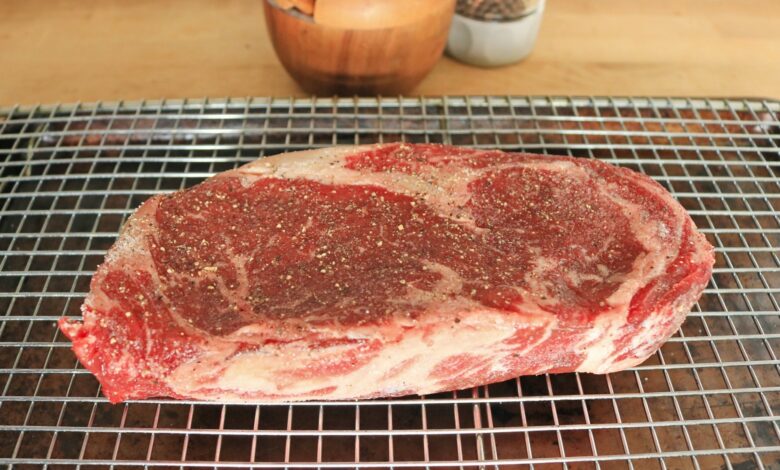The Right Way to Reverse Sear a Steak

I used to hate cooking steak at home for one big reason: the smoke. I rent an apartment in Brooklyn, which means I have to deal with a close and sensitive smoke alarm. But even without the threat of a piercing siren, steak was always one of those “sometimes” foods that ended up being more of a mess than I care to clean up.
That is, until the concept of reverse searing entered my life, and changed everything. Now I can make myself a perfect steak, and you can too.
What is reverse searing?
Searing is the classic way to prepare a steak: simply pop it in a screaming hot pan and sear it until it’s done. “Reverse searing” is the catchy phrase for first cooking a steak low and slow in a conventional oven, only tossing it in a hot pan for a few minutes afterward to get some nice color on the outside. The steak effectively cooks almost completely in the oven; you pan-sear it simply for the glorious browning and flavor the process brings.
A restaurant kitchen has industrial fans and grease traps, and getting a meal prepared in minutes is the priority. That’s an appropriate place to cook a steak quickly in a pan. But at home, there are complications—specifically, scorching, especially for newcomers learning to cook steak at home. Scorching the fats and meat is what causes smoke to fill your kitchen. And although mostly aesthetic, searing a steak over high heat will cook the protein fibers on the outside much more rapidly, shrinking the outer layer and causing the middle to bulge, and that warping of the meat makes it hard to get an even sear. Searing is primarily to add flavor, so an uneven sear actually minimizes flavor.
Why reverse searing totally rules
Reverse searing cooks the meat gently, at around 250°F, and slowly, for 20 to 50 minutes, depending on how you like your steak (and a few variables I will discuss later). Slow cooking allows the meat to warm up and heat through more evenly, keeping its shape nice and flat. The best part, if you ask me? No smoke. There is no opportunity for scorching when using this cooking technique. Well, not yet anyway. (You do sear it briefly at the end, but it’s for no where near as long.)
Moreover, it’s lower stress: Cooking this way allows you to do other things in the kitchen while the steak cooks away in the oven, and you can use a probe thermometer every 10 minutes or so to see how it’s coming along. If you have a terrible habit of overcooking your steak, this method nearly guarantees you won’t overcook it.
The right way to reverse sear a steak
1. Preheat your oven
Set your oven to 250°F. Place a wire rack over a sheet pan. There won’t be much that drips off the steak, but elevating the meat allows the warm air to flow around all sides.

Credit: Allie Chanthorn Reinmann
2. Set your target temp and bake the steak
Thoroughly season your steak and place it on the wire rack. You’re aiming for an internal temperature 10 to 15 degrees below the target finished temperature. Consider that the steak will sear in a hot pan, and also experience carry-over cooking.
I like my steak somewhere between medium-rare and medium, so if you check this steak temperature chart from Omaha Steaks, medium doneness is 140°F. I subtracted 15 degrees, and aimed for 125°F -ish. It took me 45 minutes to get to 122°F, with two temperature tests after the first 25 minutes.

Credit: Allie Chanthorn Reinmann
There are variables to keep in mind. How thick is your steak? Was it fridge-cold or room temperature? My ribeye was one-and-a-half inches thick, and still chilly from the fridge. After 25 minutes, it had just reached the internal temperature fit for a rare steak, about 102°F. My advice is to keep in mind the thickness of your steak and check on it after 10 minutes for a thin steak (around an inch thick), and after 20 or 25 minutes for a thicker one (an inch and a half or more). Once you have an initial reading, you can adjust the cooking time from there.
3. Sear in a hot pan
Once your target internal temperature has been reached, remove the steak from the oven. Heat a frying pan on medium heat until it’s very hot, which usually takes a few minutes. Sear the steak on all sides, for about one minute per side. Let the steak rest for at least five minutes before slicing.

Credit: Allie Chanthorn Reinmann
If it’s your first time reverse searing, you might be dismayed by how ugly and gray your steak looks out of the oven. Hang in there. Once you sear it, you’ll understand what it’s all about. Reverse seared steak has great flavor and looks beautiful. Although you miss out on some nice pan drippings, to me the benefits outweigh the missing fond. So say goodbye to scorching, and hello to a more relaxing, better steak experience.



